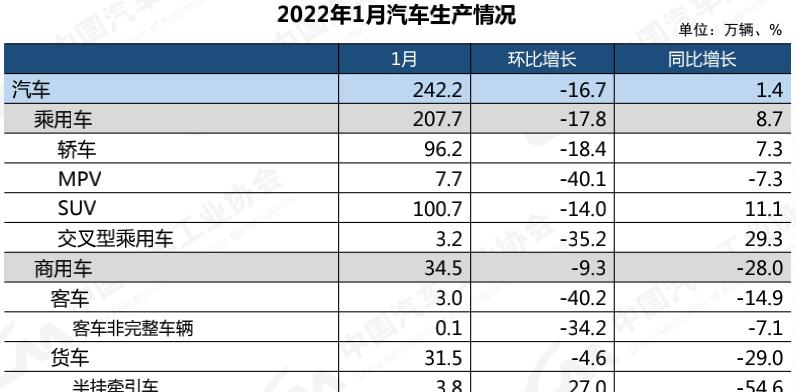On February 18, the China Association of Automobile Manufacturers released the January automobile production and sales data.
In January, the automobile production and sales situation was generally stable, declining month-on-month and maintaining a slight increase year-on-year. From the perspective of subdivision models, supported by the continued slight improvement in chip supply, superimposed on the introduction of policies to encourage automobile consumption in some places, passenger cars performed better than the overall level, and production and sales continued a stable growth trend year-on-year. Commercial vehicle production and sales continued the downward trend month-on-month and year-on-year, and the year-on-year decline was more significant. The performance of new energy and automobile exports is still outstanding, and both maintain rapid growth year-on-year.

In January, production of automobiles totaled 2.422 million units, down 16.7% and 9.2% sequentially, and 0.9% y/y, respectively. Under the background of the high base of the same period last year, the whole industry has worked together to promote the stable development of the automotive market at the beginning of 2022.
In January, production and sales of new energy vehicles totaled 452,000 units, up 1.3 times and 1.4 times, respectively, year-on-year. Although the sales of new energy vehicles this month did not refresh the historical record, they still continued the trend of rapid development last year, and the scale of production and sales was much higher than that of the same period last year. From the perspective of market share, the market share of new energy vehicles reached 17% in January, and the market share of new energy passenger vehicles reached 19.2%, which continued to be higher than the level of last year.
By model, the production and sales of pure electric vehicles reached 367,000 units and 346,000 units, up 1.2 times year-on-year, respectively; the production and sales of plug-in hybrid vehicles were 85,000 units, an increase of 2.0 times year-on-year; and the production and sales of fuel cell vehicles were 142 units and 192 units, respectively, an increase of 3.9 times and 2.0 times year-on-year.
In January, auto companies exported 231,000 units, up 3.8% month-on-month and 87.7% year-on-year. This month, automobile exports continued to continue to develop well, and the number of monthly exports was at a new level in history. By model, passenger car exports were 185,000 units this month, down 1.1% month-on-month, up 94.5% year-on-year, and commercial vehicle exports were 46,000 units, up 29.5% month-on-month and 64.8% year-on-year. The export growth contribution of new energy vehicles this month was 43.7%.
Looking forward to the first quarter, the development of the automobile market will be affected by both positive and negative aspects, of which positive factors include three points: first, local governments will actively introduce policies related to stable growth to support relatively stable market demand; second, the problem of insufficient supply of chips in the automotive industry is expected to continue to ease; third, some passenger car companies have better market expectations for 2022 and have set higher annual production targets, which will also play a certain role in supporting production and sales in the first quarter.
Unfavorable factors also include three points: first, the shortage of chips in the first quarter still exists, and the industry in the first quarter of 2021 is not affected by chips, and the base is high; second, the domestic scattered epidemic has also increased the risk of the industrial chain and supply chain; third, the current policy dividend of commercial vehicles has been basically exhausted, the demand for the superimposed transportation market is insufficient, and the freight rate is low, so commercial vehicles will be in an adjustment period in the future. In summary, we should be cautious and optimistic about the future development of the market.